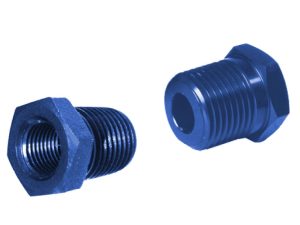
When shopping for aerospace pipe fittings, you may come across reducer bushings. They look like most other fittings. Reducer bushings have threading that allows them to connect two pipes. Only reducer bushings, however, shrink or “reduce” the diameter of the pipes with which they are used.
The Basics of Reducer Bushings
Also known as bushing reducers and reducer fittings, reducer bushings are connectors that are designed for use with a male pipe end and a female pipe end. As their name suggests, reducer bushings “reduce” the size of the pipes with which they are used. Reducer bushings feature larger external threading on one end and smaller internal threading on the other end.
How Reducer Bushings Work
Reducer bushings work by supporting pipe ends of different diameters. Like all pipe connectors, they feature threading on both ends. Reducer bushings, though, are used to join male and female pipe ends.
Male pipe ends have external threading, whereas female pipe ends have internal threading. You can connect them using a single reducer bushing. Reducer bushings have male threading on one end and smaller female threading on the other end. The reducer bushing’s male threading supports the female pipe end, and the reducer bushing’s female threading supports the male pipe end.
For additional protection against leaks, a sealing compound or PTFE tape may be applied to reducer bushings. You can apply the compound or PTFE tape to the threading. Once applied, you can then connect the pipe ends to the reducer bushing’s threading.
Choosing Reducer Bushings: What You Should Know
One of the most important things to consider when choosing reducer bushings is the size of the threading. While they all have threading — specifically internal and external threading — reducer bushings are available in different thread sizes. In the United States, thread sizes are typically measured in NPT. You can refer to a reducer bushing’s NPT sizes to determine the size of its internal threading and external threading.
You should also consider the material from which the reducer bushings are made. Aluminum is a popular material for reducer bushings. In the aerospace industry, reducer bushings are often made of aircraft-grade aluminum. They are strong, durable and highly resistant to corrosion. These properties make aluminum an excellent choice of material for reducer bushings.
Some reducer bushings are also anodized. Anodized aluminum reducer bushings are up to three times as strong as their traditional aluminum counterparts. Therefore, they tend to last longer while offering a superior degree of protection against damage and premature wear and tear.



